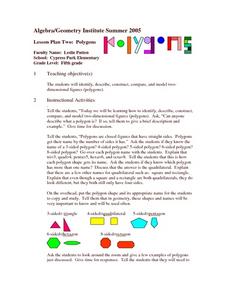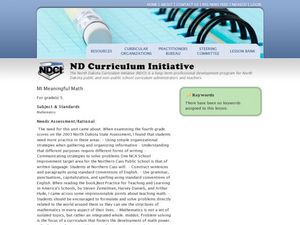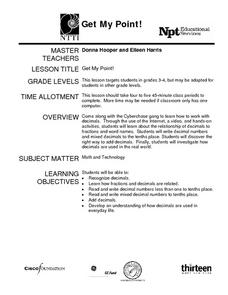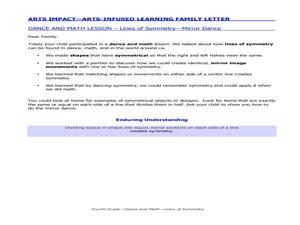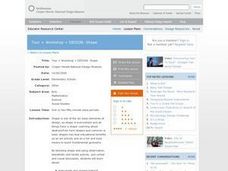Curated OER
It's Not All Greek to Me
Learners find out the meaning for prefixes used in math vocabulary. By dissecting words used in everyday math, they figure out what the prefix indicates and what the word means. A variety of well-organized worksheets and activities...
Curated OER
Everyday Problems with Decimals
Review word problems and decimals with a worksheet that features everyday problems for your students to solve. Six problems provide space for both work and the solution, reinforcing the importance of showing one's work in word problems....
Teachers Network
A World of Symmetry: Math-Geometry
Define and identify the three basic forms of symmetry translation, rotation, and glides with your class. They cut out and arrange paper pattern blocks to illustrate symmetry, create a Cartesian graph, and design a rug with a symmetrical...
Curated OER
Alice in Fractalland
Take your class on a field trip to Fractalland where they'll learn all about number and shape patterns. Based on Disney's movie Alice in Wonderland, this resource takes young mathematicians on an adventure as they explore patterns in...
Curated OER
Lesson Plan Two: Polygons
Learners explore the concept of polygons on a two-dimensional plane. They identify polygons in everyday life and draw different polygons according to their classification. Using a geoboard and geobands, they consrtuct polygons and even...
Curated OER
Patterns in Dance and Math
Students analyze how repeated body movements and shapes can represent and extend patterns. In this pattern analysis lesson plan, students discuss patterns in dance, math, and everyday living. Students demonstrate a dance using a sequence...
Curated OER
Everyday Mathematics: Multiples of 10
In this multiples of 10 worksheet, students sharpen their math skills as they learn to use multiples of 10 to help them with division and then try the 2 extra practice activities.
Curated OER
Number Patterns in Everyday Life
Examine scenarios involving number patterns. Learners complete a series of activities, including working with Pascal's triangle ando completing chart activities based on different pricing for pizza toppings. An included extension has...
Curated OER
Fractions in Everyday Life
Students apply understanding of fractions by converting a recipe to feed the class and the whole grade level. They calculate how many cookies the class would eat and multiply each fraction in the recipe accordingly.
Illustrative Mathematics
Margie Buys Apples
One of the most common, everyday applications of math is dealing with money. This single problem calculating how much change Margie receives is more involved than it appears at first glance. An understanding of how fractions and decimals...
Curated OER
MI Meaningful Math
Fifth graders increase skills in organizing information for writing. In this organization lesson, 5th graders use correct grammar to design math problems for real world math.
Curated OER
Get My Point!
Here is one of the better lessons I've come across on how to teach fractions and decimals. This lesson does a great job of showing how these two mathematical representations of numbers are interrelated. Some excellent websites, printable...
Curated OER
SuperShapes, Part 1; "Tri"ing Triangles
An outstanding lesson on triangles awaits your math scholars. Learners focus on the triangle, which is the strongest of all polygons. They see the role that triangles play in the design of buildings, and learn about triangle...
Utah Education Network (UEN)
Candies R Us
A box is fun to make, especially when it's a candy box! These activities help to cement understanding of the difference between surface area and volume. Have individuals measure the surface area of their box in two-dimensions before...
Curated OER
Design Patterns in Everyday Life
Students find symbols and patterns in everyday life. In this patterns lesson, students break into groups and look for specific patterns and symbols. Students record their findings. Students create a graphic organizer with the information.
Curated OER
Fractions Everyday
Students investigate fractions through interactive videos and hands-on activities and class made models.
Curated OER
"Math Curse" by Jon Scieszka
Students explain everyday uses of numbers and relationships of numbers.
Curated OER
Symmetry in Shapes and Everyday Objects
Fifth graders discover lines of symmetry for shapes and everyday objects. In this lines of symmetry lesson, 5th graders use a butterfly outline to find lines of symmetry. Students analyze everyday objects for symmetry and use...
Curated OER
One Step at a Time
Students investigate the customs and habits of other cultures by reading letters from a Peace Corps Volunteer. In this global customs lesson, students discuss how analyzing a culture is similar to analyzing art, no two people see...
Curated OER
Real-World Reasonableness
Fifth graders apply math to real-world situations. In this mathematics lesson, 5th graders are read the book, "Math Curse," which discusses ways in which math is used each day. Students then write a sequel to the book in groups,...
Curated OER
Problem Solving---A Part of Everyday Thinking
Young scholars demonstrate knowledge of the six basic steps to problem solving. They demonstrate ability to apply these six basic steps to problem solving by guiding other students in the solution of a given problem or set of problems.
Curated OER
Mirror, Mirror on the Wall, Who Needs Math in Life at All?
Students think and talk about the ways in which they use math throughout the day. They add each way to a "math in real life" bulletin board and reflect in writing on the ways they use math.
Curated OER
Lines of Symmetry - Mirror Dance
Fifth graders analyze how to divide space or shape into mirror sections to create lines of symmetry. In this lines of symmetry activity, 5th graders discuss symmetry in dance, math, and living. Students participate in a dance warm-up and...
Curated OER
Tour + Workshop = DESIGN: Shape
Ask elementary students to explore shapes in everyday objects. They will discuss the elements of design and describe the shapes they see in visual images. Students will then design and "build" a new 3D shape. Finally they will show and...




